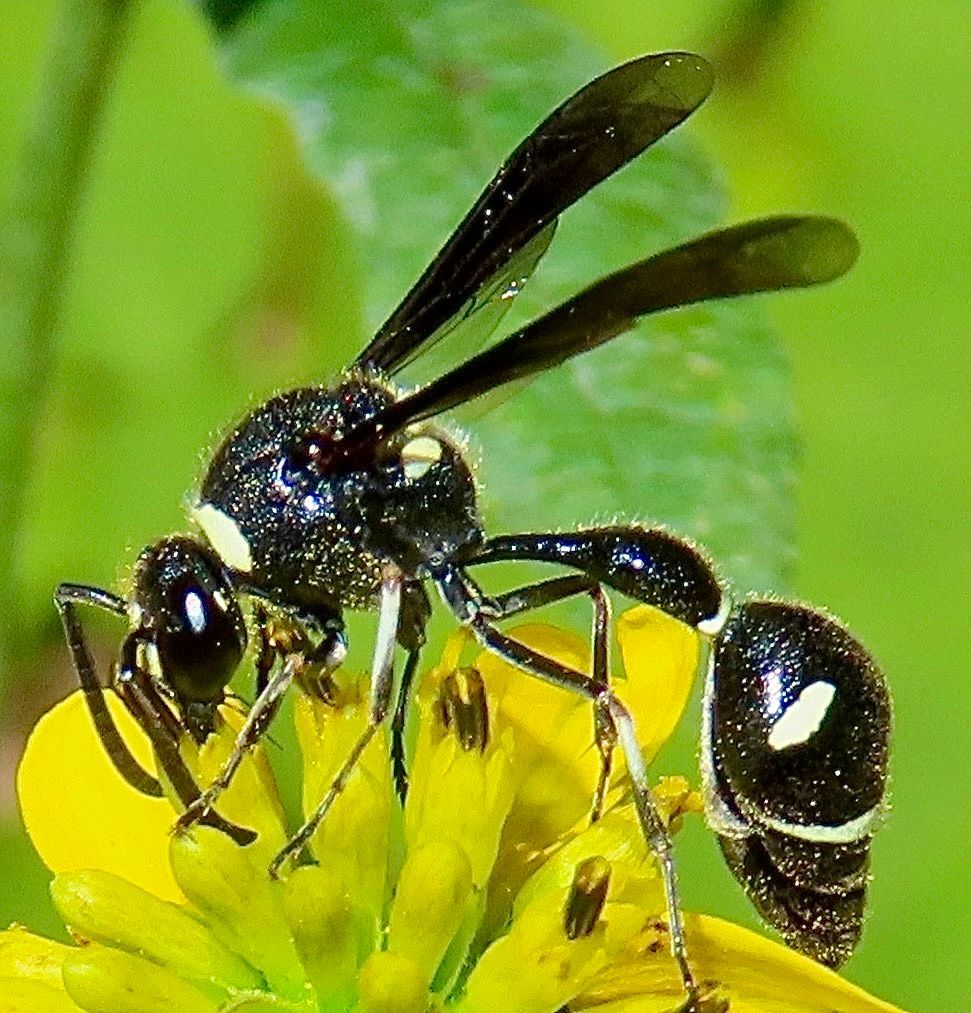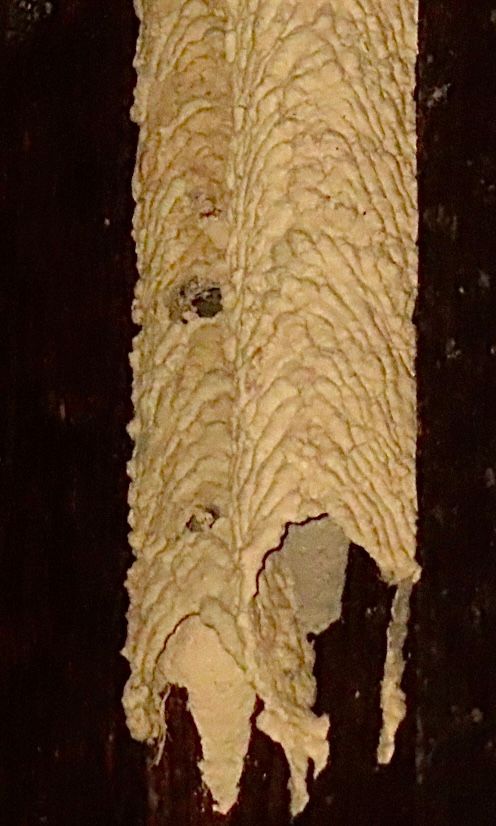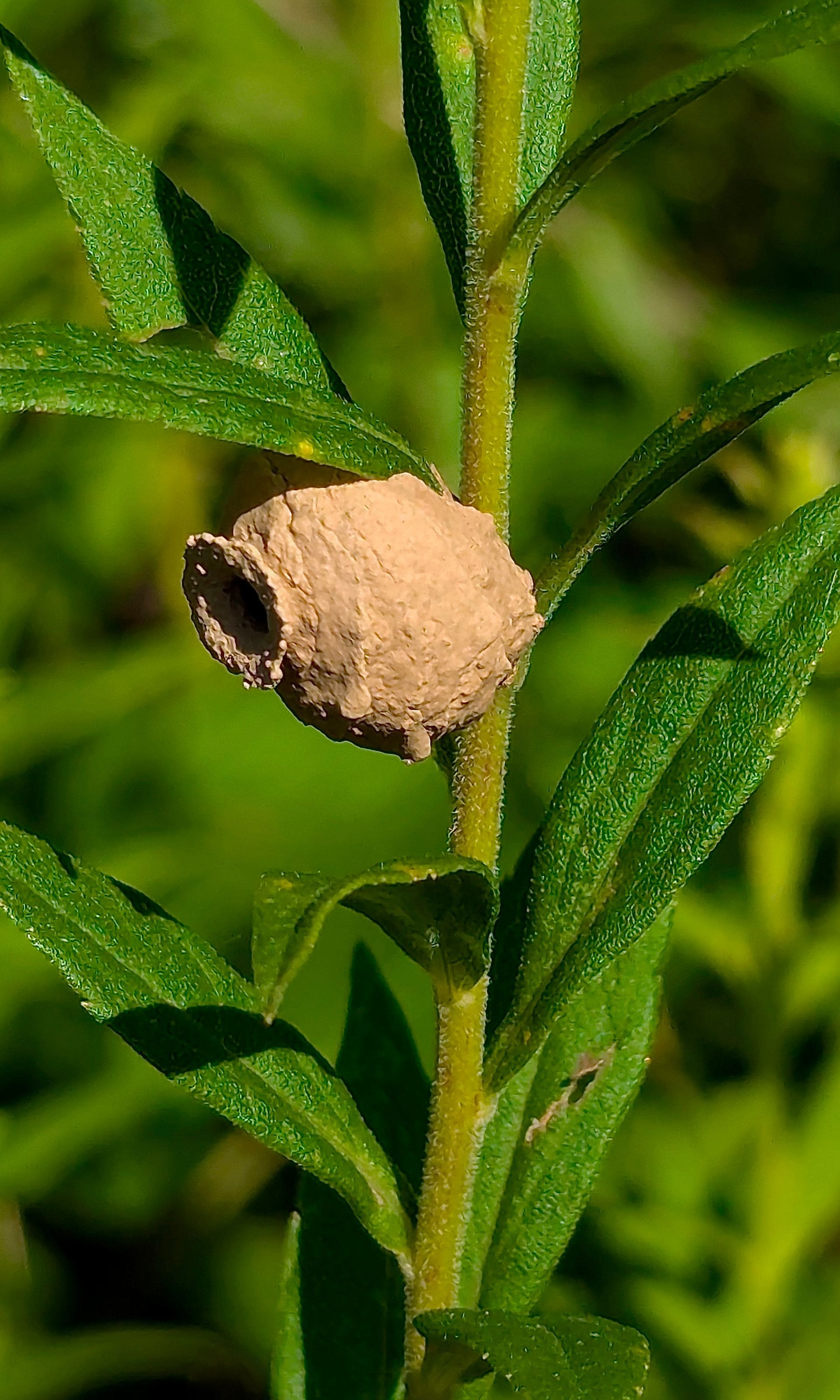What on Earth?
By Ray Barbehenn
Photos by David Cox and Karen Hendershot.
Placed high overhead and built by wasps, one of childhood's great mysteries often remains unexplored: "What is inside those Mud Dauber nests?" Even parents wouldn't know. A long broom handle and a determination to investigate would produce an indelible image: Spiders of all sorts spill out of those shattered clay tubes! Mud Dauber Wasp nests are most often seen in places that we build to protect ourselves from the weather, such as our porches and AT shelters. The wasps locate their nests in these places with the same need for protection. In the wild, their nests are tucked under overhanging rock ledges, in tree holes, and under loose tree bark. The left photo shows the nests of the Organ Pipe Mud Dauber under the eaves of a house in Fredericksburg, Virginia. This pair of "organ pipes" was about six inches long and was found by David Cox on September 10. The open ends of the "pipes" face down. Notice the series of ridges of mud that make up each tube. There are other kinds of wasps that also use mud to construct their nests. In the right photo is a Potter Wasp nest. This small, half-inch diameter nest was photographed by Karen Hendershot on a goldenrod stem on August 12 in Front Royal, Virginia. The open mouth of the "pot" faces to the left.
Why are spiders inside the nests of Mud Daubers?
A. Spiders seek shelter inside the nests during the cold months.
B. Spiders are placed inside the nests by the wasps for their larvae to eat.
C. Spiders are killed by the wasps in order to protect the wasp larvae.
Answer is at the bottom of the page!
Mother Mud Daubers fill each of the chambers in their nests with a variety of paralyzed spiders for their larvae to eat. After packing in a group of spiders, the mother Dauber lays a single egg in the chamber and seals it with a layer of mud. This is repeated for each of the three or four chambers in each of their pipe-shaped nests.
Potter Wasp nests are different than those of Mud Daubers in some basic ways. Each small Potter nest is built for only a single wasp larva, and they stock their nests with a diversity of prey: caterpillars, beetle grubs, and spiders.
Fun Facts and Musings
Spiders must be amazingly nutritious because the wasp larvae grow incredibly fast; a Mud Dauber larva can completely eat all the spiders in its tiny mud chamber and become a pupa in less than a week! (Different Mud Dauber species and different temperatures produce a wide range of growth rates, varying from less than one week to three weeks.) The mother Mud Dauber stuffs an average of eight spiders into each of the three or four chambers along each pipe. However, she might need up to 25 spiders if they are small.
Mud Daubers favor the large, ornate orb-weaving spiders that often sit at the centers of their webs. They are relatively easy to spot – perfect prey for insects that have strong flying abilities, strong grasping legs, and quick stingers. While the spiders lay in wait for insects to blunder into their silk webs, the Mud Daubers turn the tables on them, making prey of the spiders. Still, it takes roughly an hour of hunting for every spider brought back to the nest. By paralyzing the spiders, they remain fresh during the time it takes a wasp larva to develop.
"Solitary" wasps (species that make their nests alone, such as Mud Daubers and Potter Wasps) mainly use their stings to paralyze prey. They inject venom in or near the prey's nerve center that controls movement, knocking out its ability to fight or flee. By comparison, "social" wasps and bees (species that build their nests with a group effort) mainly use their stingers to defend their hives. They need to inflict pain to drive away intruders. The pain and swelling that we feel from the stings of social wasps are caused by a cocktail of chemicals in their venom. The venom produces an allergic reaction when our own defenses release "histamines." Hence, antihistamines are helpful to control the swelling from wasp or bee stings. When social wasps hunt for caterpillars, they often bite them, rather than paralyze them with venom.
The name "Mud Dauber" suggests that people compared the wasps' behavior to our application of plaster to a wall. However, if you watch a video of their construction technique (https://www.youtube.com/shorts/N3IFO3p1bvM), you will see that they actually craft their mud tubes from a series of carefully made arches. They also search out mud with certain properties that they favor for nest construction. When she has located a nearby mud site, a female Mud Dauber uses her large mandibles to scoop the mud and create a small ball. One of these mud balls is used to form each side of an arch in the nest. The wasp pushes the mud ball against the partially hardened edge of the tube to attach it, and then uses her mandibles to squeeze and stretch the ball to form a complete arch. In addition to having impressive skills at molding the mud balls into arched shapes, the wasps also compact the mud as it is applied by rapidly tapping it with their front legs and mandibles. This compaction strengthens the nest as it is being constructed. A female Mud Dauber can complete a six-inch nest tube in less than a day, and sometimes in as little as three hours. If you see a series of tubes, made side-by-side, it could be the work of just one female! The spider hunt begins as soon as she is done building each tube.
Father Mud Daubers play their main role in the family during nest construction: They guard the nest from parasitic flies and wasps, as well as other Mud Daubers that might try to take over the nest while the mother is away hunting.
Potter Wasps and Mud Daubers are not closely related but they do share some striking similarities. For example, they both make their nests by bringing balls of moist soil to the construction site and patching them together. However, the female Potter Wasp makes her own mud by spitting out water that she drank to mix with dry soil. She makes more than 20 trips to build a nest, which might take several hours. When she has filled the "pot" with paralyzed prey and laid a single egg, she seals the opening with mud. A mother Potter Wasp might make about 25 nests in her life – a lot of work for each offspring! You can probably learn as much as you want to know about Potter Wasp nest building by watching one of the wonderful short videos available, such as https://www.youtube.com/watch?v=7Sjx5gh8cgE.
Both Potter Wasp and Mud Dauber adults feed mainly on nectar from flowers. For example, a Fraternal Potter Wasp was photographed feeding in SNP in the adjoining picture (photographed by David Cox on September 2). Note its "wasp waist," which allows it to move its stinger quickly in any direction. They often thrust their stingers forward between their legs. However, like Mud Daubers, these wasps are quite docile, and unlikely to ever sting us. And, like the Mud Daubers, their venom is for paralyzing prey, rather than sending a painful message to intruders!
"What on Earth?" Answer
Answer: B!
Thanks to Dr. Lynn Kimsey (University of California, Davis) for identifying the Potter Wasp nest and Karen Hendershot for inspiring this article!
Send your photos and ideas for topics to Ray at rvb@umich.edu.



